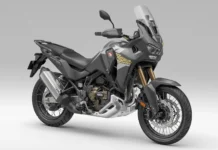To look at BMW motorcycles today, you’d never know the parent company didn’t have its roots in the motorcycle industry and came close to abandoning the motorcycle product altogether. In his new book, BMW Motorcycles – 100 Years, Alan Dowds looks back on the sometimes-tough history of BMW Motorrad with tremendous historical and technical detail.
Dowds begins the story with a background that doesn’t even include BMW. He starts with the invention of the Otto-cycle four-stroke internal combustion engine—the precursor to the development of aircraft engines for the Rapp Motorenwerke (Rapp Engine Works). The company was renamed Bayerische Flugzeugwerke (Bavarian Aircraft Works) in 1916 and, a year later, re-branded again as the Bayerische Motoren Werke (Bavarian Motor Works), which Dowds reveals is the first use of the BMW brand.
During World War I years, the BMW plant exclusively produced engines for aircraft—primarily German warplanes. The Treaty of Versailles put an end to the war and an end to BMW building engines for airplanes, as the treaty banned German aircraft production until mid-1920.
In one of those ironies that history tends to create, this forced BMW to diversify into other areas of the transportation industry, such as automobiles and motorcycles. But, even then, BMW’s first motorcycle engines didn’t power BMW-branded motorcycles. BMW’s first opposed twin—the M2B15 engine—was sold to other companies, including Victoria and Helios, for their motorcycles.
By 1923, the M2B15 engine was replaced with the M2B33, and the brand on the tank became the first BMW motorcycle—the R32. The R32 was the genesis of the boxer twin design, though its price tag kept sales down. In response, in 1925, BMW added a lower-priced model—the single-cylinder 250cc R39.
Dowds recalls the company’s progress through to the late 1930s, when politics and war again affected the company. Through the war, BMW played a crucial role in Germany’s Luftwaffe, supplying conventional piston engines and the jet engines that powered the world’s first operational jet fighter—the Messerschmitt Me 262.
The defeat of Germany, economic catastrophe, and the partition of Germany could well have ended BMW. Somehow, that didn’t happen. Starting with manufacturing things as basic as home utensils, agricultural equipment, and bicycles, BMW began the slow, steady process of rebuilding.
In 1947, the Allied Occupation force approved re-starting motorcycle production. A year later, BMW was back in the motorcycle business with the R24—an improved version of the 250cc single-cylinder R23. By 1950, bikes up to 500cc could be produced, and the boxer twin returned as the R51/2.
From there, technological progression continued. However, as the 1950s ended, the aircraft and automobile divisions of the company were flat-lining financially, and the motorcycle division was losing out to the competition.
BMW soldiered on through the 1960s against intense competition for world markets, particularly the U.S., and the horsepower race was being lost to multi-cylinder two- and four-stroke powered bikes from Japan by the decade’s end.
In 1969, BMW fought back with the R75/5, followed in 1974 by the R75/6, and in ’77 with the R75/7—all powered by a new 50 horsepower 745cc boxer engine. Added to the line in 1973 were the 898cc R90/6 and R90/S. In 1976, to finally get into the horsepower range of top-line bikes from the competition, the R100 RS was introduced, putting out 70 horsepower, displacing 980cc.
Dowds covers the golden age for motorcycle design of the 1980s with superb coverage of BMW’s K series models, which departed from the boxer twin engine entirely with a longitudinal inline-four, and the revolutionary GS series, which featured bikes designed for off-road adventure.
Despite some radical new approaches, Dowds chronicles the continued survival and evolution of the boxer engine with the emergence of the “oilhead” engine in the early 1990s with the K 1100 RS. The decade even saw BMW bring out a factory custom, the radically styled R 1200 C that was famously featured in a James Bond movie, “Tomorrow Never Dies.”
In BMW Motorcycles – 100 Years, Dowds takes us through the years of the company’s state-of-the-art-defining technological advancements up to 2021, including an R 1200 GS that takes rider safety to the extreme—by eliminating the need for a rider to be aboard!
Alan Dowds has written four other books and has been a moto-journalist since 1994.
BMW Motorcycles – 100 Years Book Fast Facts
- Author: Allan Dowds
- Published: 2022
- Book: Hardcover, 240 9.75-by-12-inch pages, 300 color and black-and-white images and illustrations.
- Publisher: Motorbooks, Quarto Publishing Group
- ISBN: 978-0-7603-7471-9
BMW Motorcycles – 100 Years Price: $60 MSRP






![2024 Suzuki V-Strom 800 Touring First Look [Fast Facts + Photos] 2024 Suzuki V-Strom 800 Touring First Look: MSRP](https://ultimatemotorcycling.com/wp-content/uploads/2023/10/2024-suzuki-v-strom-800-touring-first-look-3-218x150.webp)
![2023 Motocross of Nations Results, Video [France Dominates] 2023 Motocross Of Nations Results](https://ultimatemotorcycling.com/wp-content/uploads/2023/10/2023-motocross-of-nations-start-218x150.jpg)

